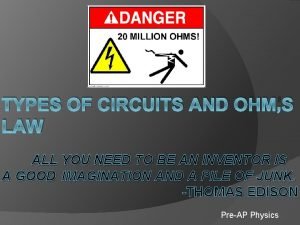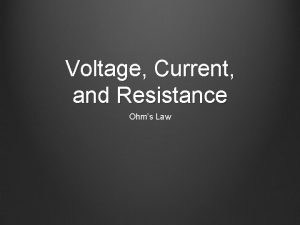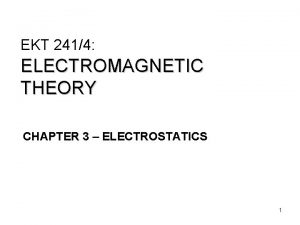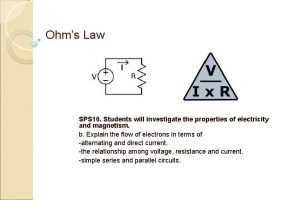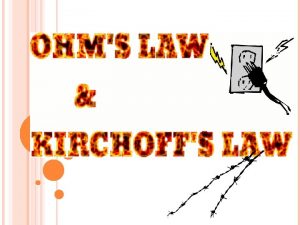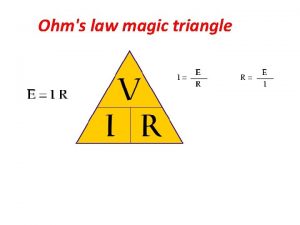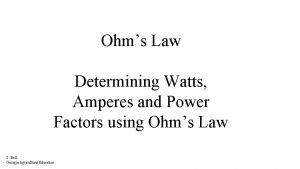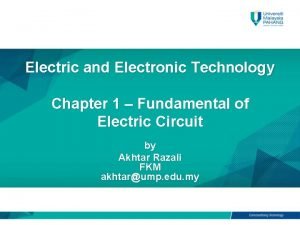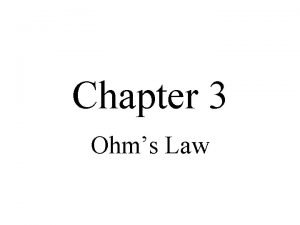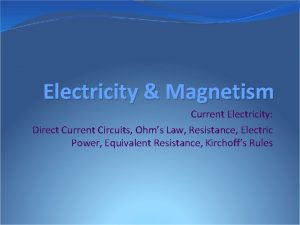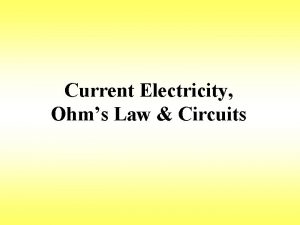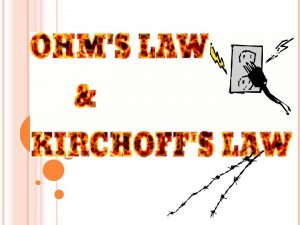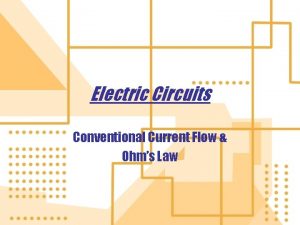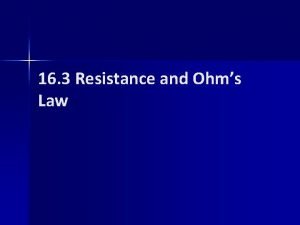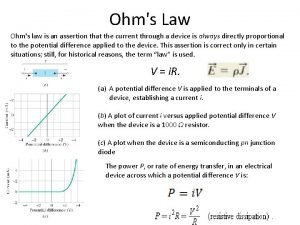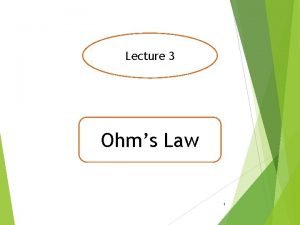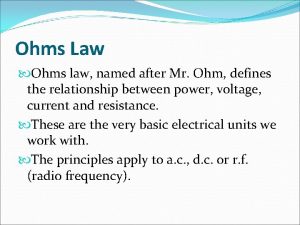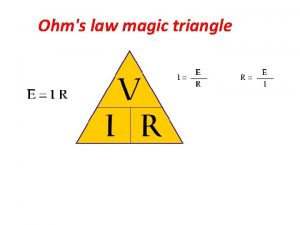Current Electricity Ohms Law Circuits Current I The















- Slides: 15

Current Electricity, Ohm’s Law & Circuits

Current (I) • The rate of flow of charges through a conductor • Needs a complete closed conducting path to flow • Must have a potential difference (voltage) • Measured with an “ammeter” in amps (A) named for Ampere – French scientist • I = current, A Q = charge, C t = time, s So: 1 Amp = 1

Voltage (V) • Electric potential difference between 2 points on a conductor. Equal to the electric potential energy per charge. • Sometimes described as “electric pressure” that makes current flow • Supplies the energy of the circuit • Measured in Volts (V) using a voltmeter • 1 Volt = 1 Joule / Coulomb

Resistance (R) • Opposition to the flow of charges. “electrical friction” of the moving charges. • Measured in Ohms (Ω) • Resistance in a wire depends on - material (low R for copper) - temperature (as T increases, R increases) - length (as length increases, R increases) - cross-sectional area ( as A incr. , R decr. )

Ohm’s Law • A relationship between voltage, current, and resistance in an electric circuit • used to make calculations in all circuit problems • V = potential difference (voltage) in volts • I = electric current in amperes (amps , A) • R = resistance in ohms ( )

Electric Power (Watts) • Used for thermal energy

Electric Energy • Electric energy can be measured in Joules (J) or Kilowatt hours ( k. Wh ) • for Joules, use Power in watts and time in seconds • for k. Wh, use Power in kilowatts and time in hours

Voltmeter and Ammeter • Ammeter – Measures Current in Amps – Placed in the path with the resistor(s) to be measured – Placed in series with whatever is being measured • Voltmeter – Measures Voltage in Volts – Placed around whatever is being measured – Placed in parallel with whatever is being measured

Series Circuits • Current can only travel through one path • Current is the same through all parts of the circuit. • The sum of the voltages of each component of the circuit must equal the total voltage of the battery. • The equivalent resistance of a series circuit is the sum of the individual resistances. R 1 V I R 3 R 2

Solving a Series Circuit Step 1: Find the equivalent (total) resistance of the circuit IT 6 V R 1=1 Ω R 2=2 Ω Remember: The current is the same throughout a series circuit so… IT = I 1 = I 2 Step 2: Find the total current supplied by the battery Step 3: Find Voltage Drop across each resistor.

Parallel Circuits • Current splits into “branches” so there is more than one path that current can take • Voltage is the same across each branch as the total voltage drop (or voltage across the battery) • Currents in each branch add to equal the total current through the battery V R 1 R 2 R 3

Solving a Parallel Circuit R 2=2Ω 12 V R 1=1Ω R 3=4Ω Step 3: Finding the current through each resistor. Remember, voltage is the same on each branch as the battery voltage. Note: Step 1 & 2 were not necessary to do step 3!! Step 1: Finding the total resistance of the circuit. Step 4: Check currents to see if the answers follow the pattern for current. Step 2: Finding the total current from the battery. The total of the branches should be equal to the sum of the individual branches.

Solving Combo Circuits – Find RT first R 2 = 7 Ω R 3 = 2 Ω R 1 = 4 Ω R 4 = 3 Ω V = 15 V Step 1: Find RT for any series within a R 2 -3 = 9 Ω R 1 = 4 Ω R 4 = 3 Ω parallel branch. R 2 -3= 7 + 2 = 9Ω Step 2: Find RT for any parallel parts. V = 15 V R 1 = 4 Ω R 2 -4 = 2. 25 Ω V = 15 V Step 3: Find RT for the series circuit. R 1 -4 = 6. 25 Ω V = 15 V

Solving Combo Circuits Step 4: Find IT using Ohm’s law. Step 5: Find the voltage across any resistors in series with the battery. Step 6: Find the voltage drop across the whole parallel part. (2 methods are shown. ) Step 7: The voltage drop across each parallel branch is the same as the total voltage drop across the parallel part (if there are not any resistors in series in that branch).

Solving Combo Circuits
 Types of circuits and ohm's law ch 7.1 answers
Types of circuits and ohm's law ch 7.1 answers Static electricity and current electricity
Static electricity and current electricity Static electricity and current electricity
Static electricity and current electricity Magnetism vocabulary
Magnetism vocabulary Current in a parallel circuit
Current in a parallel circuit Ohm's law
Ohm's law Point form of ohms law
Point form of ohms law Ohms law resistance
Ohms law resistance Ohm's law states
Ohm's law states Triangle ohm's law
Triangle ohm's law Watts law
Watts law Ohms law emf
Ohms law emf Derive ohms law
Derive ohms law Introduction of ohm's law
Introduction of ohm's law Chapter 35 electric circuits answers
Chapter 35 electric circuits answers A certain light bulb has a tungsten filament
A certain light bulb has a tungsten filament
